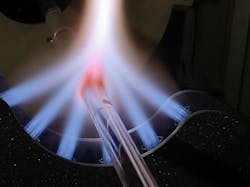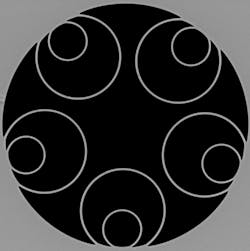Hollow-core fiber at OFC 2021: Optimizing for applications and ruggedness
Hollow-core fibers were in the spotlight again at this year’s virtual Optical Fiber Communications Conference (ofcconference.org), but the focus has broadened. It has expanded from last year’s record-low loss to cabling and applications, including fiber backhaul for 5G networks, datacenters, and long-haul transmission. The OFC 2021 postdeadline session also reported records for recirculating loops and lowest losses in multiple bands. This hot research field is growing up into a technology.
A week before OFC, British Telecommunications announced it had begun tests of a 10 km cabled hollow-core fiber at BT Labs (Ipswich, England) with Lumenisity Ltd. (Romsey, England) and global networking company Mavenir (Richardson, TX). The cable uses Lumenisity’s patented nested antiresonant nodeless fiber (NANF); its average loss is 1 dB/km, well above the 0.28 dB/km record, but adequate for testing applications.
“We’re trying to find out if hollow-core fibers really could be useful” for 5G mobile communications and secure transmission systems, says Andrew Lord, head of optical network research at BT Labs. Delays in both network equipment and transmission through solid-core fibers make latency requirements tight for 5G networks, and hollow-core fibers promise faster transmission over the 10- to 20-km scales of fiber backhaul to distribution centers. Another benefit of hollow-core fiber is very low nonlinearity, an important issue for secure networks. According to Lord, quantum-key transmission sends one photon at a time, making the Raman nonlinearity of solid-core fiber “a pain because it generates photons at wavelengths where you don’t want them.”
Other major goals are testing physical durability and thermal stability of the new cable. “With hollow-core, the packets transmitted [through the fiber] jiggle around much less” than in solid-core fiber, says Lord. High jitter becomes a problem at hundreds of gigabits per second, where it can require active stabilization.
Lumenisity at OFC
“We talk about cable because that’s what customers use,” says Lumenisity CEO David Park. So far, NANF fiber has been drawn at the University of Southampton (England), where it was developed. But now, the company is nearing completion of its own fab facility to be commissioned by year’s end (see Fig. 1). “We believe hollow-core will be complementary to standard single-mode fiber,” Park says, serving demanding applications where its lower latency, very low nonlinearity, and other properties make it cost-effective.
At OFC, Lumenisity introduced a second-generation version of its CoreSmart cable that was unveiled last year, which uses NANF fiber that transmits single-mode at 1310 nm as well as through the full C and L erbium bands spanning 1530 to 1625 nm. The new cable also provides higher bandwidth and longer reach for datacenters and 5G.
In one test with BT Labs, error-free dense wavelength-division multiplexing (DWDM) was demonstrated at 400 Gbit/s through a 10 km cable with 38 channels loaded in the C band. The demonstration included transmission of three 400 Gbit/s channels through 400ZR QSFP-DD transceivers. The 400ZR is an industry standard for pluggable network interfaces at 400 Gbit/s that allow interchangeable transceivers to be plugged in during networking operation—one in a series of standards well accepted in telecommunications. Acceptance of hollow-core fibers is a sign of their maturity.
In other tests, Lumenisity teamed with Ciena (Hanover, MD) to transmit 48 channels at 800 Gbit/s, a total of 38 Tbit/s, point to point through more than 20 km of CoreSmart cable without amplification. Both the cable and the photonics systems are commercial. According to Lumenisity, by next year, a new generation of cables should reach 50 to 100 km without amplification. A recirculating-loop experiment described in the regular sessions at OFC carried 45 channels spanning the whole C band over 1000 km, but did use amplifiers.
Post-deadline results
A seemingly minor change in the NANF design led to new records for minimum loss across a range of wavelengths. Hollow fibers with six nested tubes set the last round of records, but doing so required very careful adjustments of the microstructured cladding that either reduced loss of the fundamental mode at the cost of increased crosstalk, or increased extinction of higher-order modes at the cost of more loss in the fundamental mode.1 In the postdeadline session, Francesco Poletti of the University of Southampton reported using only five nested tubes.2 Increasing the volumes inside the tubes could reduce fundamental mode loss while increasing losses in higher-order modes, solving the problems (see Fig. 2).The five-tube fibers produced the lowest loss yet reported for any fiber type at two short wavelengths: 0.6 dB/km at 850 nm and 0.3 dB/km at 1060 nm, where solid-core fibers have higher loss. Those are half the losses of solid-core wavelengths, and together with the low dispersion and latency of hollow-core fibers, open new opportunities at those wavelengths. They also reported the lowest losses ever for hollow-core fibers at two longer wavelengths: 0.4 dB at 1310 nm and 0.22 dB/km at 1625 nm, at which the best solid-core fibers have lower losses, but hollow-core fibers have other advantages.
A team from Politechnico di Torino (Torin, Italy) and the LINKS Foundation used 11.5 km of the five-tube hollow fibers in a pair of recirculating loop experiments described by Pierluigi Poggiolini in a second postdeadline paper.3 In one, a combination of NANF and solid-core fibers looped 32 Gbaud on 41 channels in the C band up to 2070 km. In the second, they used only hollow-core fibers and reached 4020 km, with several channels going beyond 5000 km.
REFERENCES
1. M. A. Iqbal, “First demonstration of 400ZR DWDM transmission through field deployable hollow-core fiber cable,” OFC 2021, paper F4C.2.
2. F. Poletti, “Hollow core NANFs with five nested tubes and record low loss at 850, 1060, 1300 and 1625nm,” OFC 2021, postdeadline paper F3A.4.
3. P. Poggiolini, “Ultra-long-haul WDM transmission in a reduced inter-modal interference NANF hollow-core fiber,” OFC 2021, postdeadline paper F3B.5.

Jeff Hecht | Contributing Editor
Jeff Hecht is a regular contributing editor to Laser Focus World and has been covering the laser industry for 35 years. A prolific book author, Jeff's published works include “Understanding Fiber Optics,” “Understanding Lasers,” “The Laser Guidebook,” and “Beam Weapons: The Next Arms Race.” He also has written books on the histories of lasers and fiber optics, including “City of Light: The Story of Fiber Optics,” and “Beam: The Race to Make the Laser.” Find out more at jeffhecht.com.

